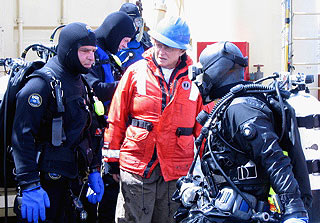| • Home |
| • Questions |
| • Participants |
| • Background Information |
The Station #3 tow had gone out at S53°24.41 W066° 57.621, at about 8k ship speed and wind at 22-25ph. Air temp is 7.5° C.

| 1 | 2 | 3 | 4 | 5 | 6 | |
| 7 | 8 | 9 | 10 | 11 | 12 | 13 |
| 14 | 15 | 16 | 17 | 18 | 19 | 20 |
| 21 | 22 | 23 | 24 | 25 | 26 | 27 |
| 28 | 29 | 30 |
| 1 | 2 | 3 | 4 | |||
| 5 | 6 | 7 | 8 | 9 | 10 | 11 |
| 12 | 13 | 14 | 15 | 16 | 17 | 18 |
| 19 | 20 | 21 | 22 | 23 | 24 | 25 |
| 26 | 27 | 28 | 29 | 30 | 31 |
This was a benthic sled trawl, which brought up what looked like just sand and small (1lb) rocks, but turned out to yield many samples, large and small. We were able to stand out on the deck at midnight and into the wee hours, sorting on a long wooden stand with a 3-inch lip and a running salt water hose. First, a shovel load of “crud” would be put on the stand, and we'd take out anything big (the size of an orange or larger). Then, using a valuable scientific tool, a dustpan from the tool room, we'd scoop up a bit and put it into a round, flat sieve, about 16 inches across. That would get rinsed down, to eliminate contraband of a size smaller than we were looking for, and the hand sorting would begin. After we had filled several buckets and jars with items worth looking into (there had to be a hundred!), we moved the operation to the lab and began the sorting, identifying and documenting, both on paper and by photo. I quit the scene around 4am, but when I got up around 11:30, the last of the sorting and pickling was still happening. This is no small task, when you’re looking at samples at a part of the world that was so difficult to reach in the first place, there’s no second chance!
I turned in around 5am, and could already smell the special meal ahead already being prepared… The noon meal was a Thanksgiving Feast with turkey and ham, and all the fixin’s. There were even traditional pecan and mincemeat pies for dessert. I believe the spirit of the day was truly there, with everyone (from North America, anyway) acknowledging the day and the special personal meaning it has. A few of us missed (in good humor) the trademark cranberry sauce, however... Can’t imagine it being on the grocery shelves of Punta Arenas, now, can you?
I made a stop at the Bridge today (story for another day). It's gorgeous from up there! The people at that station really know the birds: giant petrels, cape petrels and black browed albatross were doing lazy circles around the ship.
Today, Dive Operations were put into play at last (Station #6; Stations# 4 and #5 were plankton and bottom, respectively, with good results), and the gelatinous zooplankton team (jelly hunters) suited up and rode the wild Zodiac to their first Antarctic dive (well, almost Antarctic). One of today’s divers, Sandy Williams of WHOI, wrote of the experience with great enthusiasm:
“The Zodiac dive boat was launched with Jamie, our female MT [marine technician] to start the engine and tend lines and then Brennan, one of the divers, climbed down the ladder to get the rest of us aboard. Brennan was the tender, a diver so he knew the drill but not in a suit and staying on the surface. Jeff, our safety diver, Larry, our PI scientist, Erich, experienced Antarctic diver, and I were suited up. We drove 1/4 mile away and deployed a float with line and dove on that. The bottom was nearly a hundred meters away. The water at 40 feet was clear except for transparent organisms every couple of feet. Salps, our principal target, are colonial tunicates (pre vertebrate chordates, sort of related to us). They were abundant. Also ctenophores, siphonophores, and smaller bits. I captured as many as I carried jars for and 25 minutes into my dive, I returned to the surface where I couldn't get back into the Zodiac without assistance. But when everyone else was done and returned to the surface, Larry helped me unbuckle my BC and without that weight, I was able to be helped aboard.
Among my captures in the ten or so jars I filled were salps, a giant (4" long) ctenophore [common in Cape Cod waters, clear except for lengthwise rows of tiny cilia that “glow” when stirred up in summer night waters], and a siphonophore that looked to me like a wisp of smoke. I also caught what I thought was a pair of milkweed pods but were actually a pair of salps in a different life stage. It was really neat seeing and capturing all these things. Pat, Kerri, and Brennan immediately went to work collecting fecal material deposited by the salps in their jars since their capture. Nothing is wasted. Pat studies how fast a salp processes the particles it captures on a mucous net it produces and swallows.”

Salps are being processed and photographed and shared among other interested parties before they fade, die and turn to wet Kleenex. We are steaming now to our next benthic tow later this evening. It's been a productive, pleasant day.
Dinner Menu (shipboard, 11/25): |
|
Noon
Meal: Turkey breast, ham, stuffing, mashed potatoes,
cauliflower, sauerkraut, gravy, and
pies. |